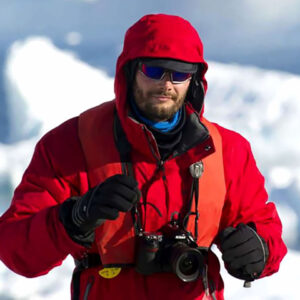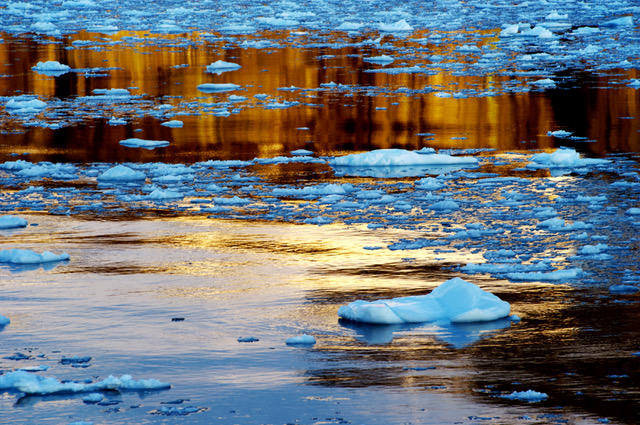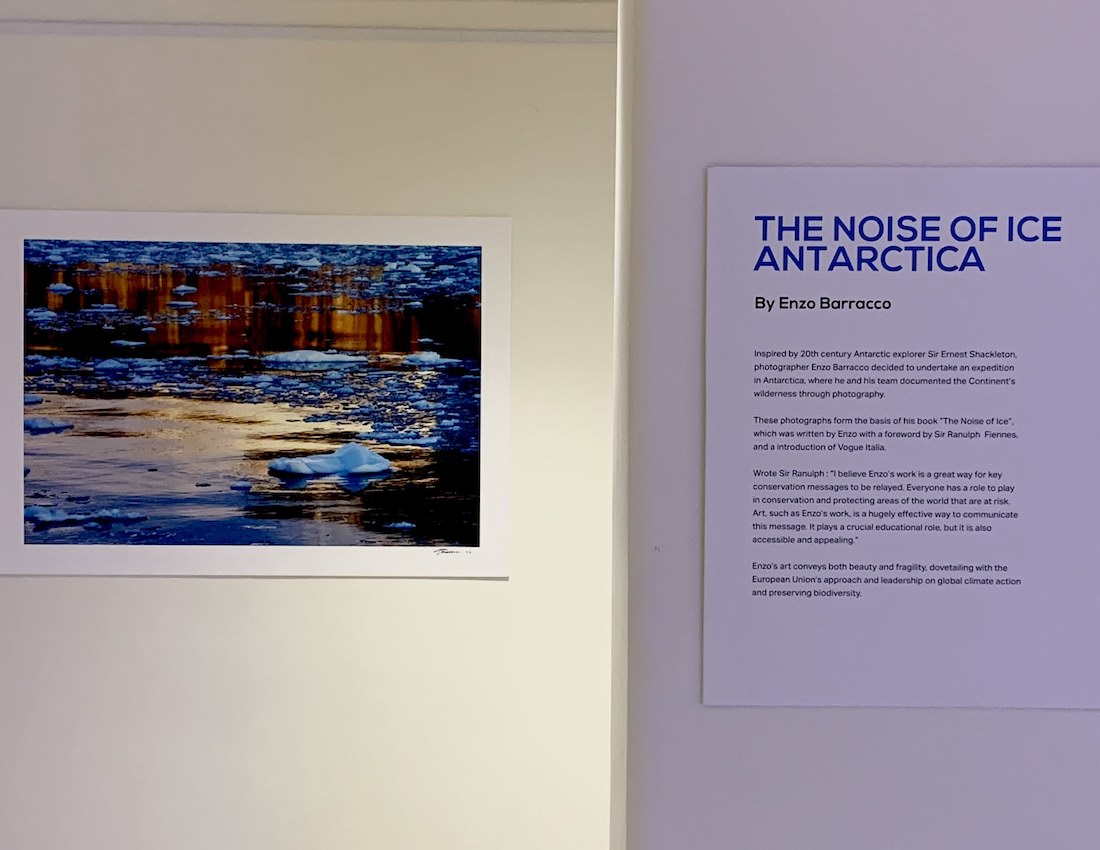The famous saying “A picture is worth a thousand words” is particularly fitting when walking inside the United Nations’ building in New York and through the large open space that leads you from the halls where diplomatic meetings are held, to the Vienna Café.
In that space, some of Enzo Barracco’s photos from both Antarctica and the Galapagos Islands have been on display since last Thursday. Just last year, La Voce di New York wrote about this Sicilian photographer, who has lived in London for quite some time and has years of experience in the fashion industry. That was when Barracco’s book, The Noise of Ice: Antarctica, was published, and when his lens turned from fashion and business to nature and the environment.
When we found out that his photos would be celebrated inside of the UN, because of the work of the European Union’s Diplomatic Mission at the United Nations, we couldn’t miss a chance to meet with him in front of one of those intense images. And when, while talking with Barracco, we found out that he was born in the same little town I was, intensity turned into deep emotion.
“Being here is a great privilege for me,” he explained in front of his shots, representing the essence of climate change. “I hope that my work can result in people’s surprise and inspire curiosity for the natural world, in order to create a new dialogue with nature. This prestigious building is perfect to communicate this idea.”

Barracco’s mission is to reawaken human knowledge, enticing each and every individual to respect nature and treat it as a work of art. He does this through photos from the most remote corners of the earth.
“Although we think we know nature, it always has the ability to surprise us. The wildest places on earth hold the key to understanding the ways the natural world works. We know the data, we have the numbers, but we are missing the images.”
According to the Sicilian photographer, we are all responsible for the changes that are happening to our climate and, because of this, we each have “the duty to do something for nature, to the best of our abilities.” He continues by saying: “I do it with photography because it does not need to be translated, it just gets straight to the point without needing captions or explanations. One image can, sometimes, tell a very complex story. Today, for example, the diplomats who came to see the unveiling did not need translators, each of them stopped in front of the picture that was able to communicate something to them and started to observe it, creating a connection with its main subject.”

United Nation diplomats will be able to enjoy the magnificence of his work until February the 12th. His iceberg is the most impressive shot, because it is the one that represents global warming the best. Barracco enjoys telling people about the adventures he had in Antarctica, where he captured this enormous mass of ice.
“There were several challenges in taking the picture, including the logistics,” he explained. “In these remote areas, nature decides who can and cannot go where, and you often have to wait hours for the perfect conditions. It isn’t the same as when I worked in fashion. In a studio you control the set and the lights, while in nature you must adapt to the circumstances with plenty of patience. Obviously, the landscape is mostly white, so the reflections and the right exposure were hard to handle. Another challenging element was the weather. The extreme cold made the camera’s battery die much faster than usual, but the thing I remember most vividly was the power of the wind. At some points, it was hard for me to breathe.”

I asked him, “Have you ever been scared?” and he replied, “One day, my team and I were exploring a bay on board of a dinghy. It was a beautiful day: there were whales all around us and the albatrosses were flying in the bright blue sky. Everything was perfect. I started to get closer to a tall wall of ice, comparable to a skyscraper in New York City. I started taking pictures but I immediately felt fearful, something was off. I decided to continue to shoot, but that feeling was getting stronger. It’s hard to explain it with words, it was extreme fear, an emotion I had never experienced before. Suddenly I looked up and the albatrosses were no longer there. Everything became quiet. I immediately decided to remove myself from the majestic wall of ice and I barely had time to turn the dinghy around before the cliff started to collapse into the ocean, creating a series of massive waves and making a myriad of pieces of ice, as large as buses, fall. The noise caused by the ice cracking apart was the loudest I have ever heard. Powerful and full-bodied. This is the experience from which I got the title for my book, ‘The Noise of Ice Antarctica’.”

After his exploration of the glaciers and the publication of the book, Barracco is now planning other exhibits of his Antarctica project in several cities across the United States. Right now, he is working on a project about the Galapagos islands, and his book The Skin of the Rock Galapagos will come out by the end of the year.
“To bring the project to life, I had to involve numerous people and international institutions”, he told us, “and I am extremely happy about the enthusiasm and the support that the new project is getting. After the beautiful and intense experience in Antarctica, I thought that no other natural place could amaze me, but the Galapagos did. It is a very wild place, full of incredible flora and fauna, with a unique ability to adapt. It seemed like, at any point, a dinosaur could appear from behind a rock. A very primordial place. Trying to take pictures and focus on one animal at a time was difficult because in a single square meter there were often up to ten different species. The challenge was in keeping the other animals from entering the frame.”
The uniqueness of the area was what convinced this climate artist to start a new adventure. The Galapagos are “the spot in which three major ocean currents meet, creating a richness of life like no other. I hope that the Galapagos can be an example: they are the perfect place to understand our oceans and the transformation that they are undergoing a little better. A transformation in which we are deeply involved and by which we are strongly affected.” For his new work, Barracco even received an Emmy nomination.

While traveling the world, the Palermo native does not forget his origins, and he hopes to be able to work on a project about Sicily soon. “It is a land full of contradictions,” he said, “that, like Palermo, inspired me deeply.
The sea at Mazara del Vallo and my first dips in the Strait of Sicily were a fundamental source of inspiration for me, that sparked my passion and respect for the ocean. It’s been a long time since I’ve lived in Italy, but I must say, we have a cultural and environmental heritage that can’t be found anywhere else in the world.
There is an endless choice of things to do. You can just point your finger and find a fantastic photographic project. Because I’m from Sicily I would like to tour the island on a sailboat and explore the entire coast. It’s a trip I have always wanted to take since I was a little kid.”

Barracco, however, is also thinking about New York. “The city absolutely is a subject I am interested in,” he explained. “In the past I have often thought about creating a project about it, but nature ended up taking over and I keep on postponing it. New York has a speed and enthusiasm in doing and creating that affects everyone: sometimes it drags you, sometimes it carries you, always with a very unique energy. Plus, its architecture–some larger than life and some on a human scale–creates a very interesting visual diversity. And, from time to time, early in the morning or right before sunset, the sunlight creates truly unique images.”
Alessandra Loiero contributed to this interview.
Translated by Emma Pistarino.











